O-Band and C/L-Band III-V Quantum Dot Lasers Monolithically Grown on Ge and Si Substrate
Abstract
:Featured Application
Abstract
1. Introduction
2. O-Band and C/L-Band III-V Quantum Dot Devices via III-V/IV Hybrid Growth
2.1. C/L-Band InAs Quantum Dots on Ge Substrate
2.2. O-Band and C/L-Band InAs/GaAs Quantum Dots on (111)-Faceted Si Hollow Substrate
3. InAs QD Microcavity Lasers on (111)-Faceted Hollow Si (001) Substrate
3.1. Optically-Pumped QD Micropillar Laser on Si Substrate
3.2. InAs QD Microdisk Laser on Si Substrate
4. Conclusions
Author Contributions
Funding
Conflicts of Interest
References
- Liu, A.Y.; Srinivasan, S.; Norman, J.; Gossard, A.C.; Bowers, J.E. Quantum dot lasers for silicon photonics. Photonic Res. 2015, 3, B1–B9. [Google Scholar] [CrossRef]
- Zhou, Z.; Yin, B.; Michel, J. On-chip light sources for silicon photonics. Light Sci. Appl. 2015, 4, e358. [Google Scholar] [CrossRef]
- Wang, Z.; Abbasi, A.; Dave, U.; Groote, A.; Kumari, S.; Kunert, B.; Merckling, C.; Pantouvaki, M.; Shi, Y.; Tian, B.; et al. Novel Light Source Integration Approaches for Silicon Photonics. Laser Photonics Rev. 2017, 11, 1700063. [Google Scholar] [CrossRef] [Green Version]
- Chen, X.; Li, C.; Tsang, H.K. Device engineering for silicon photonics. NPG Asia Mater. 2011, 3, 34. [Google Scholar] [CrossRef]
- Rickman, A. The commercialization of silicon photonics. Nat. Photonics 2014, 8, 579–582. [Google Scholar] [CrossRef]
- David, T.; Aaron, Z.; John, E.B.; Tin, K.; Graham, T.R.; Laurent, V.; Delphine, M.-M.; Eric, C.; Léopold, V.; Jean-Marc, F.; et al. Roadmap on silicon photonics. J. Opt. 2016, 18, 073003. [Google Scholar] [Green Version]
- Malka, D.; Cohen, E.; Zalevsky, Z. Design of 4 × 1 Power Beam Combiner Based on MultiCore Photonic Crystal Fiber. Appl. Sci. 2017, 7, 695. [Google Scholar] [CrossRef]
- Sintov, Y.; Malka, D.; Zalevsky, Z. Prospects for diode-pumped alkali-atom-based hollow-core photonic-crystal fiber lasers. Opt. Lett. 2014, 39, 4655–4658. [Google Scholar] [CrossRef]
- Mi, Z.; Yang, J.; Bhattacharya, P.; Qin, G.; Ma, Z. High-Performance Quantum Dot Lasers and Integrated Optoelectronics on Si. Proc. IEEE 2009, 97, 1239–1249. [Google Scholar] [CrossRef]
- Sugawara, M.; Usami, M. Handling the heat. Nat. Photonics 2009, 3, 30–31. [Google Scholar] [CrossRef]
- Asghari, M.; Krishnamoorthy, A.V. Energy-efficient communication. Nat. Photonics 2011, 5, 268–270. [Google Scholar] [CrossRef]
- Heck, M.J.R.; Bowers, J.E. Energy Efficient and Energy Proportional Optical Interconnects for Multi-Core Processors: Driving the Need for On-Chip Sources. IEEE J. Sel. Top. Quantum Electron. 2014, 20, 332–343. [Google Scholar] [CrossRef]
- Reed, G.T.; Mashanovich, G.; Gardes, F.Y.; Thomson, D.J. Silicon optical modulators. Nat. Photonics 2010, 4, 518–526. [Google Scholar] [CrossRef] [Green Version]
- Xiao, X.; Xu, H.; Li, X.; Li, Z.; Chu, T.; Yu, Y.; Yu, J. High-speed, low-loss silicon Mach–Zehnder modulators with doping optimization. Opt. Express 2013, 21, 4116–4125. [Google Scholar] [CrossRef] [PubMed]
- Streshinsky, M.; Ding, R.; Liu, Y.; Novack, A.; Yang, Y.; Ma, Y.; Tu, X.; Chee, E.K.S.; Lim, A.E.-J.; Lo, P.G.-Q.; et al. Low power 50 Gb/s silicon traveling wave Mach-Zehnder modulator near 1300 nm. Opt. Express 2013, 21, 30350–30357. [Google Scholar] [CrossRef] [PubMed]
- Dosunmu, O.I.; Cannon, D.D.; Emsley, M.K.; Kimerling, L.C.; Unlu, M.S. High-speed resonant cavity enhanced Ge photodetectors on reflecting Si substrates for 1550-nm operation. IEEE Photonics Technol. Lett. 2005, 17, 175–177. [Google Scholar] [CrossRef]
- Yin, T.; Cohen, R.; Morse, M.M.; Sarid, G.; Chetrit, Y.; Rubin, D.; Paniccia, M.J. 31GHz Ge n-i-p waveguide photodetectors on Silicon-on-Insulator substrate. Opt. Express 2007, 15, 13965–13971. [Google Scholar] [CrossRef] [PubMed]
- Vivien, L.; Polzer, A.; Marris-Morini, D.; Osmond, J.; Hartmann, J.M.; Crozat, P.; Cassan, E.; Kopp, C.; Zimmermann, H.; Fédéli, J.M. Zero-bias 40Gbit/s germanium waveguide photodetector on silicon. Opt. Express 2012, 20, 1096–1101. [Google Scholar] [CrossRef]
- Bauters, J.F.; Davenport, M.L.; Heck, M.J.R.; Doylend, J.K.; Chen, A.; Fang, A.W.; Bowers, J.E. Silicon on ultra-low-loss waveguide photonic integration platform. Opt. Express 2013, 21, 544–555. [Google Scholar] [CrossRef] [Green Version]
- Heck, M.J.R.; Bauters, J.F.; Davenport, M.L.; Spencer, D.T.; Bowers, J.E. Ultra-low loss waveguide platform and its integration with silicon photonics. Laser Photonics Rev. 2014, 8, 667–686. [Google Scholar] [CrossRef]
- Zheng, X.; Shubin, I.; Li, G.; Pinguet, T.; Mekis, A.; Yao, J.; Thacker, H.; Luo, Y.; Costa, J.; Raj, K.; et al. A tunable 1x4 silicon CMOS photonic wavelength multiplexer/demultiplexer for dense optical interconnects. Opt. Express 2010, 18, 5151–5160. [Google Scholar] [CrossRef] [PubMed]
- Tan, D.T.H.; Ikeda, K.; Zamek, S.; Mizrahi, A.; Nezhad, M.P.; Krishnamoorthy, A.V.; Raj, K.; Cunningham, J.E.; Zheng, X.; Shubin, I.; et al. Wide bandwidth, low loss 1 by 4 wavelength division multiplexer on silicon for optical interconnects. Opt. Express 2011, 19, 2401–2409. [Google Scholar] [CrossRef]
- Liang, D.; Bowers, J.E. Recent progress in lasers on silicon. Nat. Photonics 2010, 4, 511–517. [Google Scholar] [CrossRef]
- Rong, H.; Liu, A.; Jones, R.; Cohen, O.; Hak, D.; Nicolaescu, R.; Fang, A.; Paniccia, M. An all-silicon Raman laser. Nature 2005, 433, 292–294. [Google Scholar] [CrossRef] [PubMed] [Green Version]
- Chang, H.-H.; Fang, A.W.; Sysak, M.N.; Park, H.; Jones, R.; Cohen, O.; Raday, O.; Paniccia, M.J.; Bowers, J.E. 1310nm silicon evanescent laser. Opt. Express 2007, 15, 11466–11471. [Google Scholar] [CrossRef] [PubMed]
- Wirths, S.; Geiger, R.; von den Driesch, N.; Mussler, G.; Stoica, T.; Mantl, S.; Ikonic, Z.; Luysberg, M.; Chiussi, S.; Hartmann, J.M.; et al. Lasing in direct-bandgap GeSn alloy grown on Si. Nat. Photonics 2015, 9, 88–92. [Google Scholar] [CrossRef] [Green Version]
- Yodo, T.; Tamura, M.; Saitoh, T. Relationship between the optical and structural properties in GaAs heteroepitaxial layers grown on Si substrates. J. Cryst. Growth 1994, 141, 331–342. [Google Scholar] [CrossRef]
- Subramanian, A.Z.; Ryckeboer, E.; Dhakal, A.; Peyskens, F.; Malik, A.; Kuyken, B.; Zhao, H.; Pathak, S.; Ruocco, A.; De Groote, A.; et al. Silicon and silicon nitride photonic circuits for spectroscopic sensing on-a-chip. Photonic Res. 2015, 3, B47–B59. [Google Scholar] [CrossRef]
- Bernhardt, B.; Ozawa, A.; Jacquet, P.; Jacquey, M.; Kobayashi, Y.; Udem, T.; Holzwarth, R.; Guelachvili, G.; Hänsch, T.W.; Picqué, N. Cavity-enhanced dual-comb spectroscopy. Nat. Photonics 2009, 4, 55–57. [Google Scholar] [CrossRef] [Green Version]
- Foster, M.A.; Salem, R.; Geraghty, D.F.; Turner-Foster, A.C.; Lipson, M.; Gaeta, A.L. Silicon-chip-based ultrafast optical oscilloscope. Nature 2008, 456, 81–84. [Google Scholar] [CrossRef]
- Silverstone, J.W.; Bonneau, D.; O’Brien, J.L.; Thompson, M.G. Silicon Quantum Photonics. IEEE J. Sel. Top. Quantum Electron. 2016, 22, 390–402. [Google Scholar] [CrossRef]
- Sun, J.; Timurdogan, E.; Yaacobi, A.; Hosseini, E.S.; Watts, M.R. Large-scale nanophotonic phased array. Nature 2013, 493, 195–199. [Google Scholar] [CrossRef] [PubMed]
- Hermans, M.; Burm, M.; Van Vaerenbergh, T.; Dambre, J.; Bienstman, P. Trainable hardware for dynamical computing using error backpropagation through physical media. Nat. Commun. 2015, 6, 6729. [Google Scholar] [CrossRef] [PubMed] [Green Version]
- Fischer, R.; Masselink, W.T.; Klem, J.; Henderson, T.; McGlinn, T.C.; Klein, M.V.; Morkoç, H.; Mazur, J.H.; Washburn, J. Growth and properties of GaAs/AlGaAs on nonpolar substrates using molecular beam epitaxy. J. Appl. Phys. 1985, 58, 374–381. [Google Scholar] [CrossRef]
- Mitsuru, S.; Hidefumi, M.; Yoshio, I.; Yoshihisa, S.; Masami, T. 1.5 µm-Long-Wavelength Multiple Quantum Well Laser on a Si Substrate. Jpn. J. Appl. Phys. 1991, 30, 3876–3878. [Google Scholar]
- Liu, H.Y.; Wang, T.; Jiang, Q.; Hogg, R.; Tutu, F.; Pozzi, F.; Seeds, A. Long-wavelength InAs/GaAs quantum-dot laser diode monolithically grown on Ge substrate. Nat. Photonics 2011, 5, 416–419. [Google Scholar] [CrossRef]
- Wang, T.; Lee, A.; Tutu, F.; Seeds, A.; Liu, H.; Jiang, Q.; Groom, K.; Hogg, R. The effect of growth temperature of GaAs nucleation layer on InAs/GaAs quantum dots monolithically grown on Ge substrates. Appl. Phys. Lett. 2012, 100, 052113. [Google Scholar] [CrossRef]
- Andrew, L.; Huiyun, L.; Alwyn, S. Semiconductor III–V lasers monolithically grown on Si substrates. Semicond. Sci. Technol. 2013, 28, 015027. [Google Scholar]
- Lee, A.D.; Jiang, Q.; Tang, M.; Zhang, Y.; Seeds, A.J.; Liu, H. InAs/GaAs Quantum-Dot Lasers Monolithically Grown on Si, Ge, and Ge-on-Si Substrates. IEEE J. Sel. Top. Quantum Electron. 2013, 19, 1901107. [Google Scholar] [CrossRef]
- Jiang, Q.; Tang, M.; Chen, S.; Wu, J.; Seeds, A.; Liu, H. InAs/GaAs quantum-dot superluminescent diodes monolithically grown on a Ge substrate. Opt. Express 2014, 22, 23242–23248. [Google Scholar] [CrossRef]
- Liu, A.Y.; Zhang, C.; Norman, J.; Snyder, A.; Lubyshev, D.; Fastenau, J.M.; Liu, A.W.K.; Gossard, A.C.; Bowers, J.E. High performance continuous wave 1.3 μm quantum dot lasers on silicon. Appl. Phys. Lett. 2014, 104, 041104. [Google Scholar] [CrossRef]
- Tang, M.; Chen, S.; Wu, J.; Jiang, Q.; Dorogan, V.G.; Benamara, M.; Mazur, Y.I.; Salamo, G.J.; Seeds, A.; Liu, H. 1.3-μm InAs/GaAs quantum-dot lasers monolithically grown on Si substrates using InAlAs/GaAs dislocation filter layers. Opt. Express 2014, 22, 11528–11535. [Google Scholar] [CrossRef]
- Chen, S.; Tang, M.; Wu, J.; Jiang, Q.; Dorogan, V.; Benamara, M.; Mazur, Y.; Salamo, G.; Liu, H. Long-Wavelength InAs/GaAs Quantum-Dot Light Emitting Sources Monolithically Grown on Si Substrate. Photonics 2015, 2, 646. [Google Scholar] [CrossRef]
- Mingchu, T.; Siming, C.; Jiang, W.; Qi, J.; Dongyoung, K.; Alwyn, S.; Huiyun, L. Optimisation of 1.3-μm InAs/GaAs Quantum-Dot Lasers Monolithically Grown on Si Substrates. J. Phys. Conf. Ser. 2015, 619, 012011. [Google Scholar]
- Tang, M.; Wu, J.; Chen, S.; Jiang, Q.; Seeds, A.J.; Liu, H.; Dorogan, V.G.; Benamara, M.; Mazur, Y.; Salamo, G. Optimisation of the dislocation filter layers in 1.3-μm InAs/GaAs quantum-dot lasers monolithically grown on Si substrates. IET Optoelectron. 2015, 9, 61–64. [Google Scholar] [CrossRef]
- Chen, S.; Li, W.; Wu, J.; Jiang, Q.; Tang, M.; Shutts, S.; Elliott, S.N.; Sobiesierski, A.; Seeds, A.J.; Ross, I.; et al. Electrically pumped continuous-wave III–V quantum dot lasers on silicon. Nat. Photonics 2016, 10, 307–311. [Google Scholar] [CrossRef] [Green Version]
- Orchard, J.R.; Shutts, S.; Sobiesierski, A.; Wu, J.; Tang, M.; Chen, S.; Jiang, Q.; Elliott, S.; Beanland, R.; Liu, H.; et al. In situ annealing enhancement of the optical properties and laser device performance of InAs quantum dots grown on Si substrates. Opt. Express 2016, 24, 6196–6202. [Google Scholar] [CrossRef]
- Chen, S.; Tang, M.; Wu, J.; Liao, M.; Seeds, A.; Liu, H. III-IV quantum dot lasers epitaxially grown on Si. In Proceedings of the 2017 Conference on Lasers and Electro-Optics Pacific Rim (CLEO-PR), Singapore, 31 July–4 August 2017; pp. 1–2. [Google Scholar]
- Tang, M.; Chen, S.; Wu, J.; Jiang, Q.; Kennedy, K.; Jurczak, P.; Liao, M.; Beanland, R.; Seeds, A.; Liu, H. Optimizations of Defect Filter Layers for 1.3-μm InAs/GaAs Quantum-Dot Lasers Monolithically Grown on Si Substrates. IEEE J. Sel. Top. Quantum Electron. 2016, 22, 50–56. [Google Scholar] [CrossRef]
- Shi, B.; Zhu, S.; Li, Q.; Wan, Y.; Hu, E.L.; Lau, K.M. Continuous-Wave Optically Pumped 1.55 μm InAs/InAlGaAs Quantum Dot Microdisk Lasers Epitaxially Grown on Silicon. ACS Photonics 2017, 4, 204–210. [Google Scholar] [CrossRef]
- Shi, B.; Li, Q.; Lau, K.M. Epitaxial growth of high quality InP on Si substrates: The role of InAs/InP quantum dots as effective dislocation filters. J. Appl. Phys. 2018, 123, 193104. [Google Scholar] [CrossRef] [Green Version]
- Wang, J.; Hu, H.; Yin, H.; Bai, Y.; Li, J.; Wei, X.; Liu, Y.; Huang, Y.; Ren, X.; Liu, H. 1.3 μm InAs/GaAs quantum dot lasers on silicon with GaInP upper cladding layers. Photonics Res. 2018, 6, 321–325. [Google Scholar] [CrossRef]
- Wan, Y.; Norman, J.; Li, Q.; Kennedy, M.J.; Liang, D.; Zhang, C.; Huang, D.; Zhang, Z.; Liu, A.Y.; Torres, A.; et al. 1.3 μm submilliamp threshold quantum dot micro-lasers on Si. Optica 2017, 4, 940–944. [Google Scholar] [CrossRef]
- Jhang, Y.-H.; Mochida, R.; Tanabe, K.; Takemasa, K.; Sugawara, M.; Iwamoto, S.; Arakawa, Y. Direct modulation of 1.3 μm quantum dot lasers on silicon at 60 °C. Opt. Express 2016, 24, 18428–18435. [Google Scholar] [CrossRef] [PubMed]
- Inoue, D.; Jung, D.; Norman, J.; Wan, Y.; Nishiyama, N.; Arai, S.; Gossard, A.C.; Bowers, J.E. Directly modulated 1.3 μm quantum dot lasers epitaxially grown on silicon. Opt. Express 2018, 26, 7022–7033. [Google Scholar] [CrossRef] [PubMed]
- Chen, S.; Liao, M.; Tang, M.; Wu, J.; Martin, M.; Baron, T.; Seeds, A.; Liu, H. Electrically pumped continuous-wave 1.3 μm InAs/GaAs quantum dot lasers monolithically grown on on-axis Si (001) substrates. Opt. Express 2017, 25, 4632–4639. [Google Scholar] [CrossRef] [PubMed]
- Liu, A.Y.; Peters, J.; Huang, X.; Jung, D.; Norman, J.; Lee, M.L.; Gossard, A.C.; Bowers, J.E. Electrically pumped continuous-wave 1.3 μm quantum-dot lasers epitaxially grown on on-axis (001) GaP/Si. Opt. Lett. 2017, 42, 338–341. [Google Scholar] [CrossRef]
- Jung, D.; Herrick, R.; Norman, J.; Jan, C.; Caranto, N.; Torres, A.; Wan, Y.; Gossard, A.C.; Bowers, J.E. Highly Improved Reliability of Low Threshold 1.3 μm III/V Quantum Dot Laser Epitaxially Grown on On-axis Si. In Proceedings of the Conference on Lasers and Electro-Optics, San Jose, CA, USA, 13–18 May 2018; p. SW3Q.2. [Google Scholar]
- Liu, H.Y.; Sellers, I.R.; Badcock, T.J.; Mowbray, D.J.; Skolnick, M.S.; Groom, K.M.; Gutiérrez, M.; Hopkinson, M.; Ng, J.S.; David, J.P.R.; et al. Improved performance of 1.3 μm multilayer InAs quantum-dot lasers using a high-growth-temperature GaAs spacer layer. Appl. Phys. Lett. 2004, 85, 704–706. [Google Scholar] [CrossRef]
- Wan, Y.; Li, Q.; Geng, Y.; Shi, B.; Lau, K.M. InAs/GaAs quantum dots on GaAs-on-V-grooved-Si substrate with high optical quality in the 1.3 μm band. Appl. Phys. Lett. 2015, 107, 081106. [Google Scholar] [CrossRef]
- Liao, M.; Chen, S.; Liu, Z.; Wang, Y.; Ponnampalam, L.; Zhou, Z.; Wu, J.; Tang, M.; Shutts, S.; Liu, Z.; et al. Low-noise 1.3 μm InAs/GaAs quantum dot laser monolithically grown on silicon. Photonics Res. 2018, 6, 1062–1066. [Google Scholar] [CrossRef]
- Wan, Y.; Li, Q.; Liu, A.Y.; Gossard, A.C.; Bowers, J.E.; Hu, E.L.; Lau, K.M. Optically pumped 1.3 μm room-temperature InAs quantum-dot micro-disk lasers directly grown on (001) silicon. Opt. Lett. 2016, 41, 1664–1667. [Google Scholar] [CrossRef]
- Liu, H.Y.; Hopkinson, M.; Harrison, C.N.; Steer, M.J.; Frith, R.; Sellers, I.R.; Mowbray, D.J.; Skolnick, M.S. Optimizing the growth of 1.3 μm InAs/InGaAs dots-in-a-well structure. J. Appl. Phys. 2003, 93, 2931–2936. [Google Scholar] [CrossRef]
- Zhu, S.; Shi, B.; Li, Q.; Lau, K.M. 1.5 μm quantum-dot diode lasers directly grown on CMOS-standard (001) silicon. Appl. Phys. Lett. 2018, 113, 221103. [Google Scholar] [CrossRef]
- Kroemer, H.; Polasko, K.J.; Wright, S.C. On the (110) orientation as the preferred orientation for the molecular beam epitaxial growth of GaAs on Ge, GaP on Si, and similar zincblende-on-diamond systems. Appl. Phys. Lett. 1980, 36, 763–765. [Google Scholar] [CrossRef]
- Lee, A.; Jiang, Q.; Tang, M.; Seeds, A.; Liu, H. Continuous-wave InAs/GaAs quantum-dot laser diodes monolithically grown on Si substrate with low threshold current densities. Opt. Express 2012, 20, 22181–22187. [Google Scholar] [CrossRef]
- Chen, S.; Tang, M.; Jiang, Q.; Wu, J.; Dorogan, V.G.; Benamara, M.; Mazur, Y.I.; Salamo, G.J.; Smowton, P.; Seeds, A.; et al. InAs/GaAs Quantum-Dot Superluminescent Light-Emitting Diode Monolithically Grown on a Si Substrate. ACS Photonics 2014, 1, 638–642. [Google Scholar] [CrossRef]
- Wei, W.-Q.; Wang, J.-H.; Gong, Y.; Shi, J.-A.; Gu, L.; Xu, H.-X.; Wang, T.; Zhang, J.-J. C/L-band emission of InAs QDs monolithically grown on Ge substrate. Opt. Mater. Express 2017, 7, 2955–2961. [Google Scholar] [CrossRef]
- Wei, W.-Q.; Wang, J.-H.; Zhang, B.; Zhang, J.-Y.; Wang, H.-L.; Feng, Q.; Xu, H.-X.; Wang, T.; Zhang, J.-J. InAs QDs on (111)-faceted Si (001) hollow substrates with strong emission at 1300 nm and 1550 nm. Appl. Phys. Lett. 2018, 113, 053107. [Google Scholar] [CrossRef]
- Zhang, J.J.; Rastelli, A.; Schmidt, O.G.; Bauer, G. Role of the wetting layer for the SiGe Stranski–Krastanow island growth on planar and pit-patterned substrates. Semicond. Sci. Technol. 2011, 26, 014028. [Google Scholar] [CrossRef]
- Li, Q.; Ng, K.W.; Lau, K.M. Growing antiphase-domain-free GaAs thin films out of highly ordered planar nanowire arrays on exact (001) silicon. Appl. Phys. Lett. 2015, 106, 072105. [Google Scholar] [CrossRef] [Green Version]
- Wan, Y.; Li, Q.; Liu, A.Y.; Gossard, A.C.; Bowers, J.E.; Hu, E.L.; Lau, K.M. Temperature characteristics of epitaxially grown InAs quantum dot micro-disk lasers on silicon for on-chip light sources. Appl. Phys. Lett. 2016, 109, 011104. [Google Scholar] [CrossRef] [Green Version]
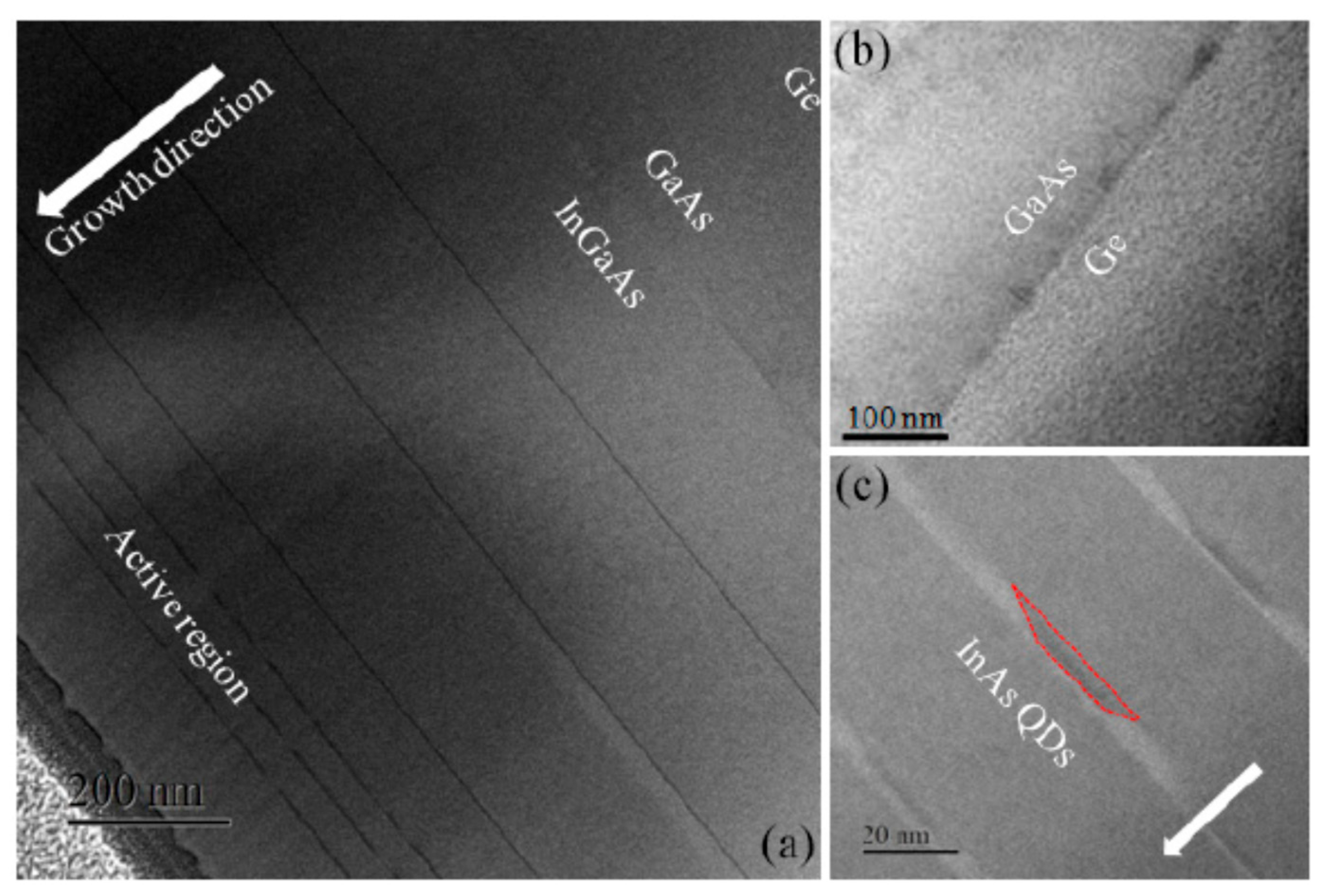

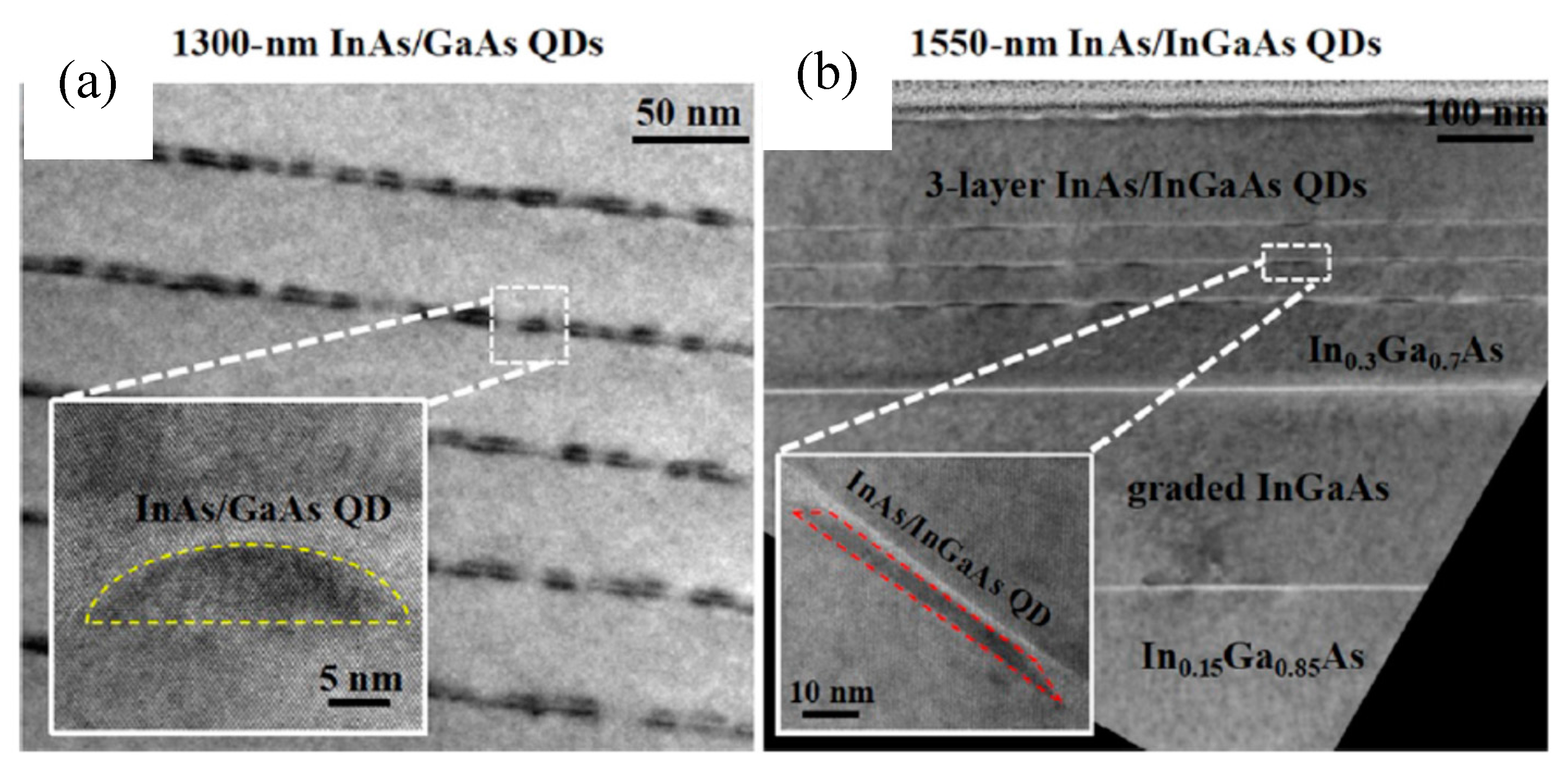
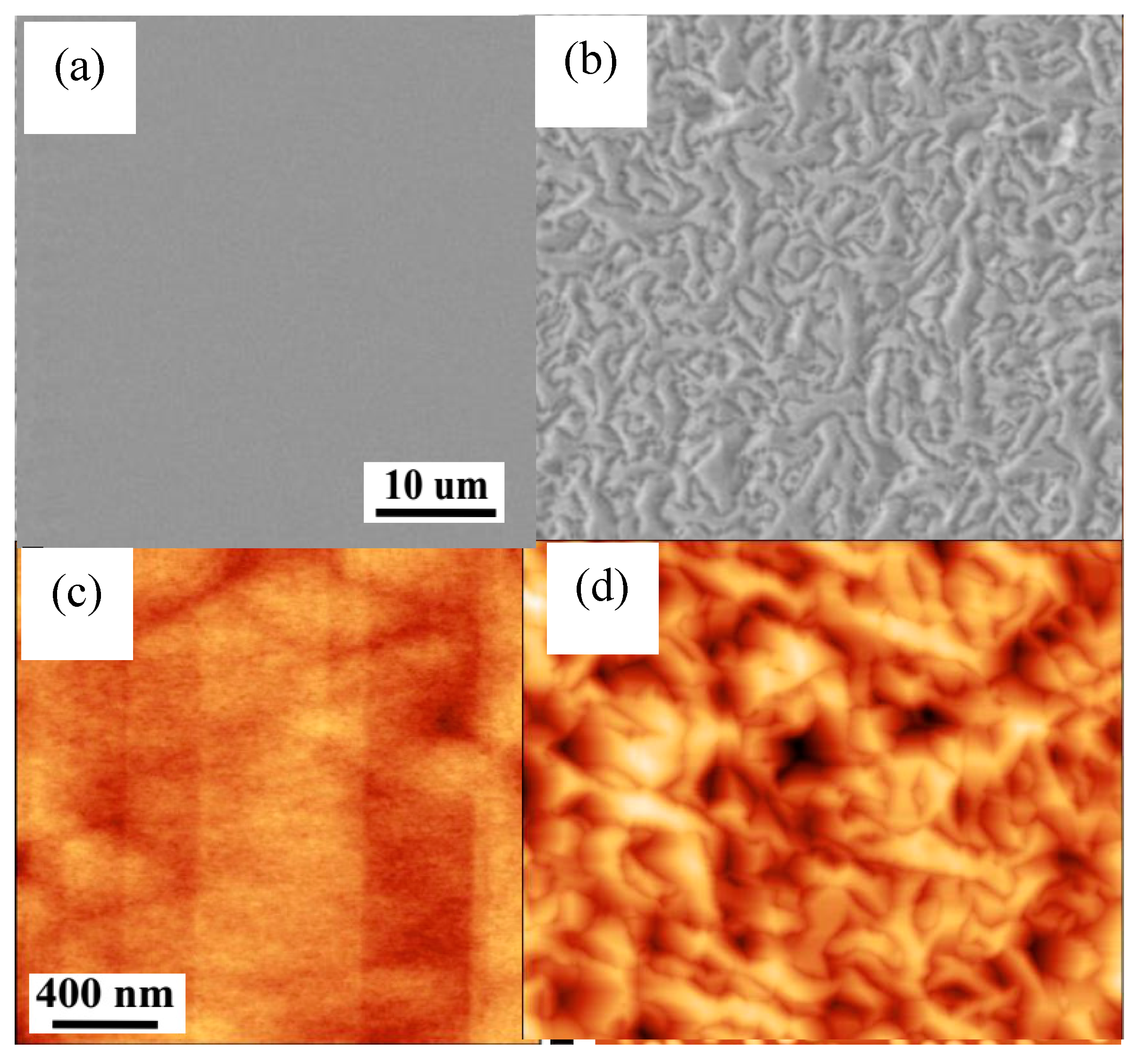
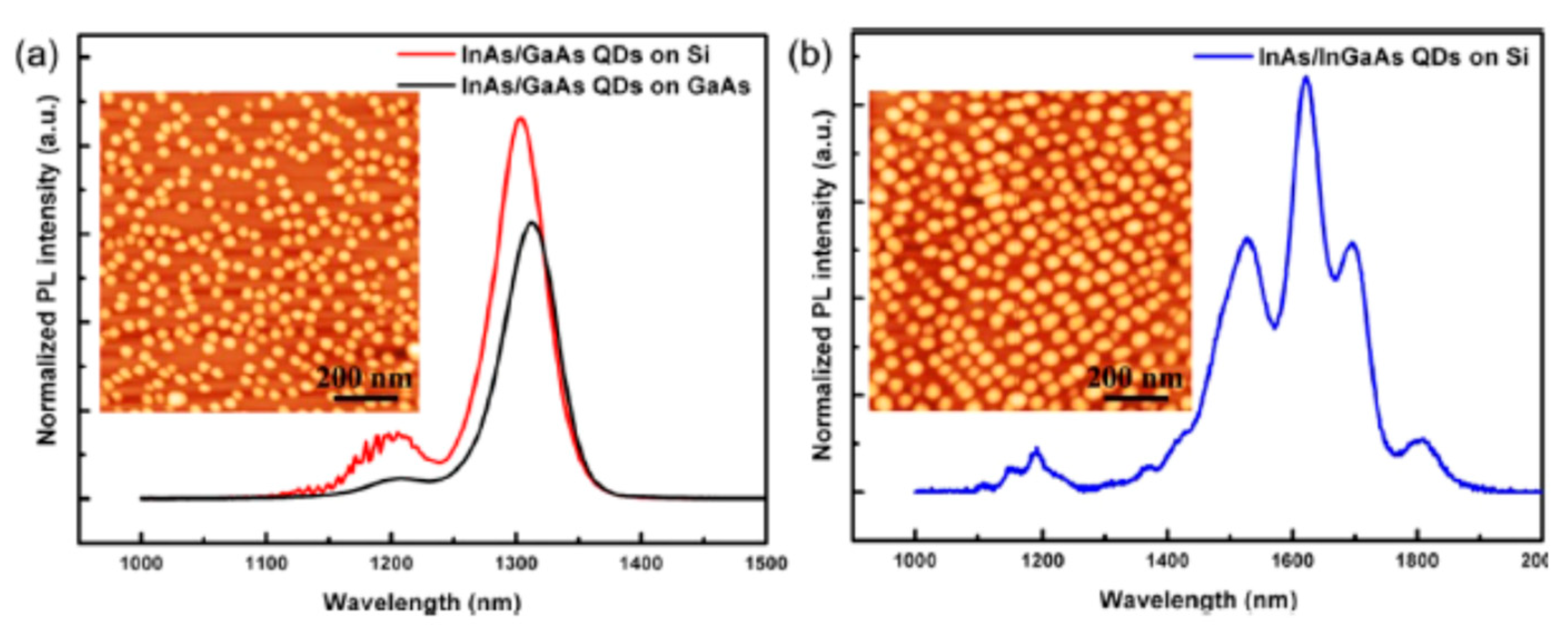
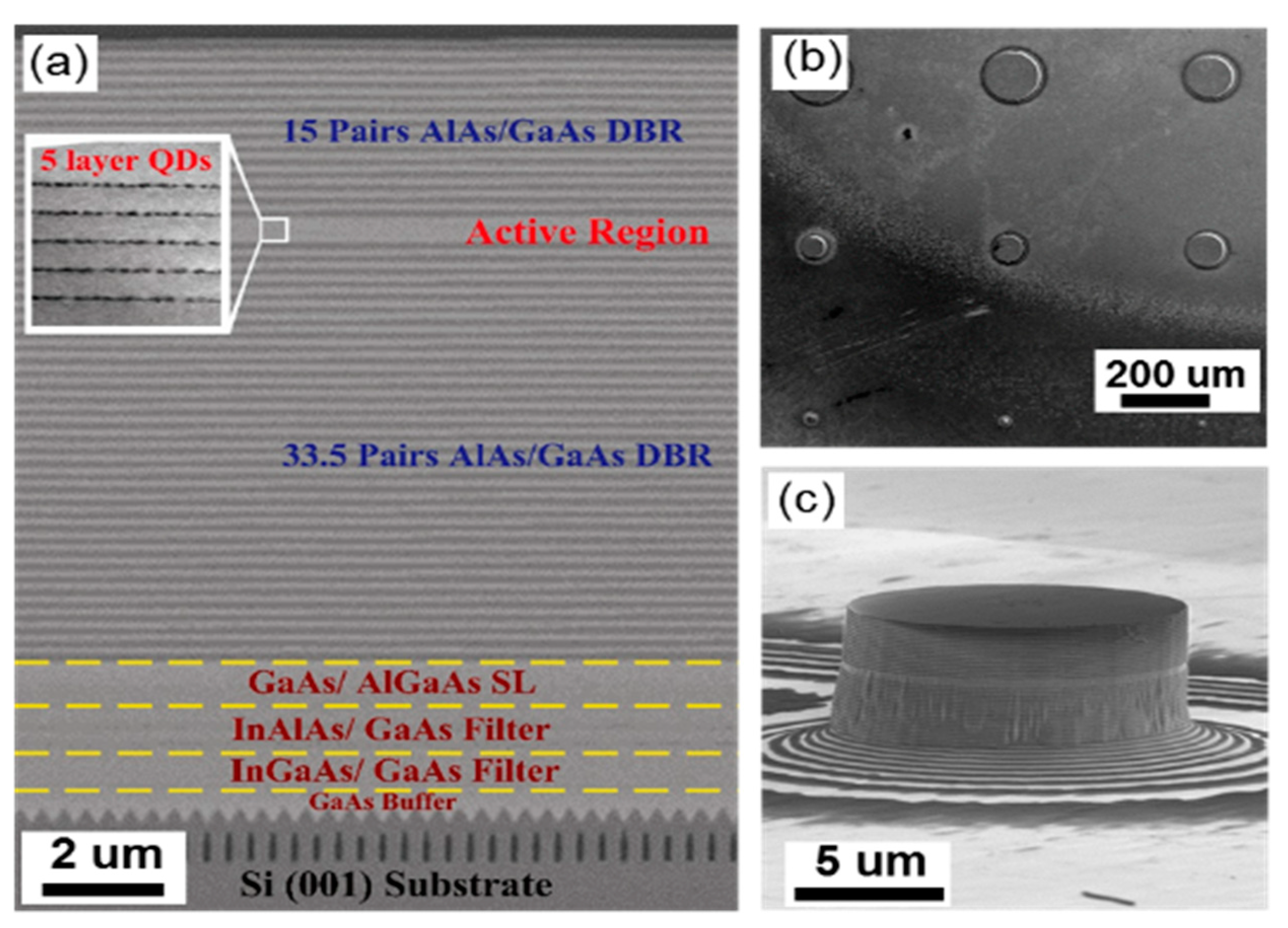
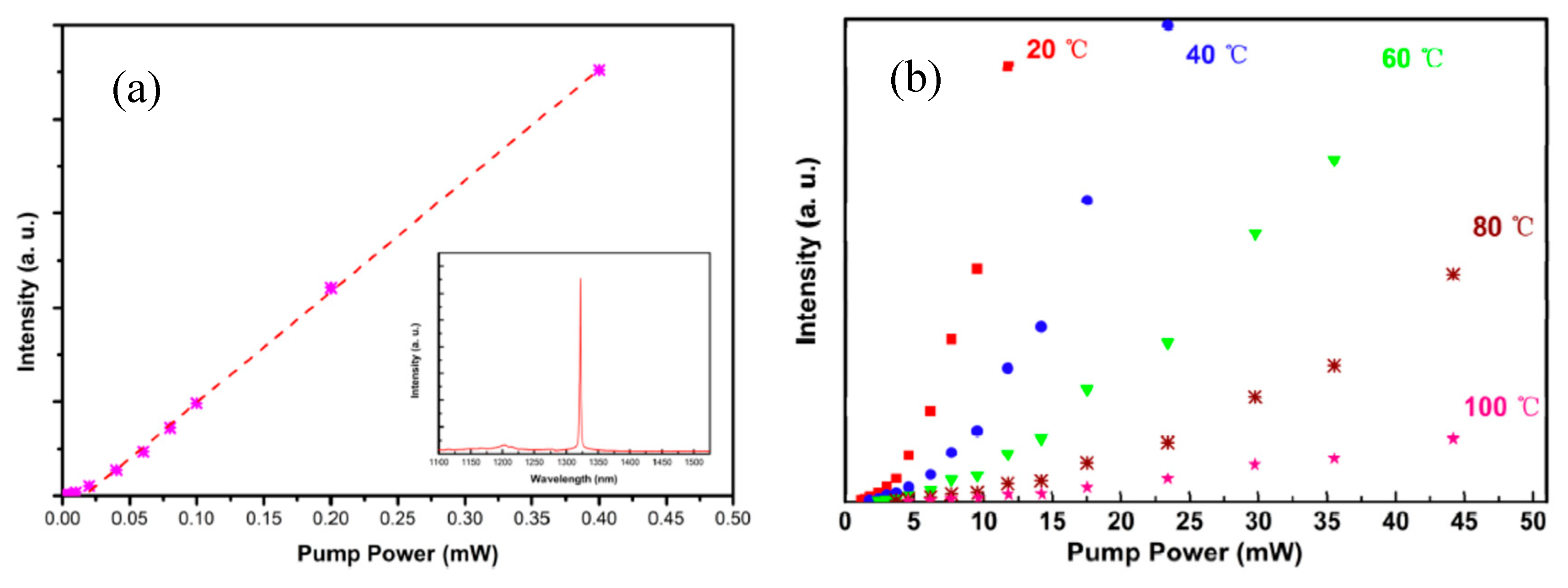


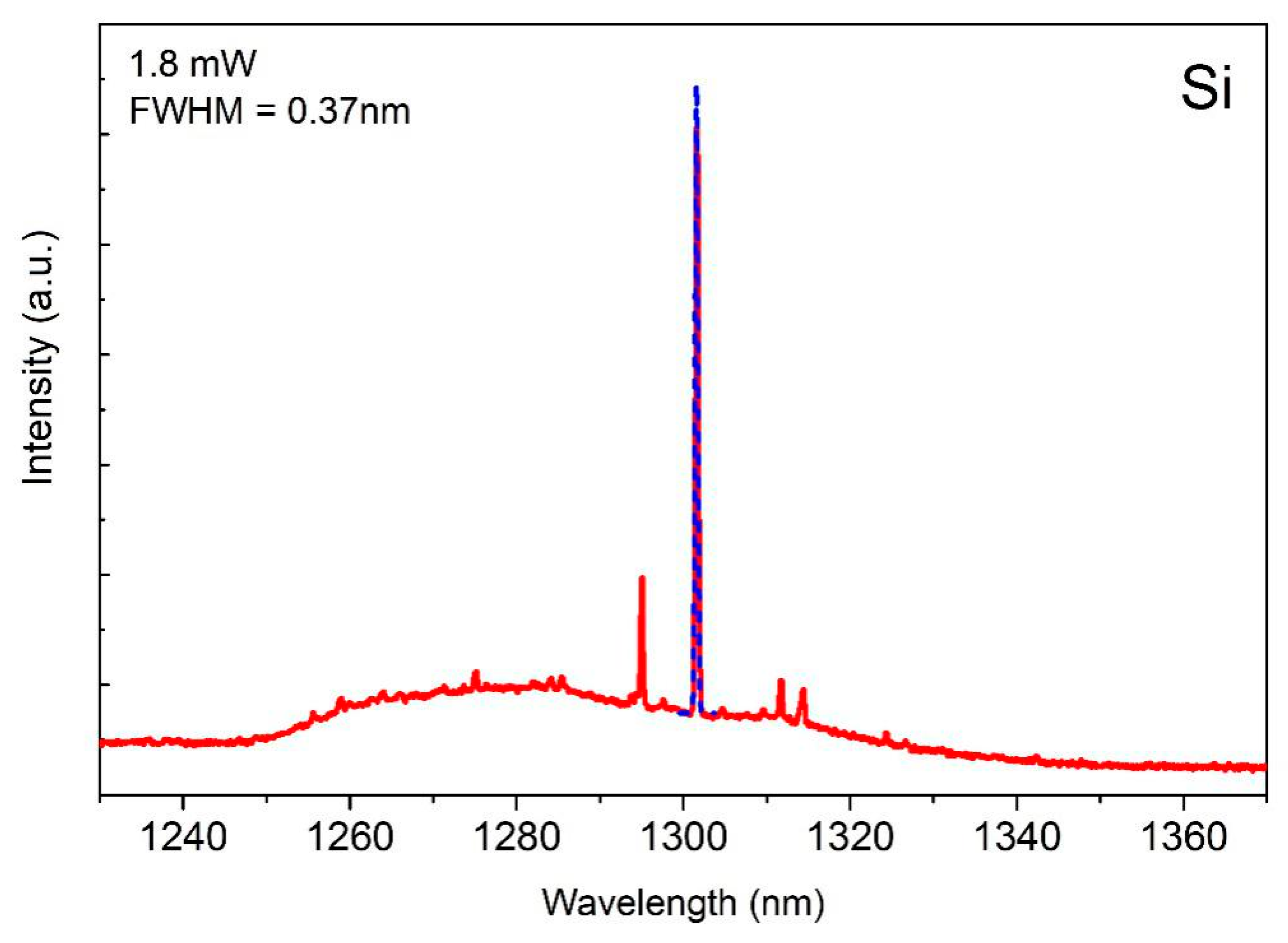
© 2019 by the authors. Licensee MDPI, Basel, Switzerland. This article is an open access article distributed under the terms and conditions of the Creative Commons Attribution (CC BY) license (http://creativecommons.org/licenses/by/4.0/).
Share and Cite
Feng, Q.; Wei, W.; Zhang, B.; Wang, H.; Wang, J.; Cong, H.; Wang, T.; Zhang, J. O-Band and C/L-Band III-V Quantum Dot Lasers Monolithically Grown on Ge and Si Substrate. Appl. Sci. 2019, 9, 385. https://doi.org/10.3390/app9030385
Feng Q, Wei W, Zhang B, Wang H, Wang J, Cong H, Wang T, Zhang J. O-Band and C/L-Band III-V Quantum Dot Lasers Monolithically Grown on Ge and Si Substrate. Applied Sciences. 2019; 9(3):385. https://doi.org/10.3390/app9030385
Chicago/Turabian StyleFeng, Qi, Wenqi Wei, Bin Zhang, Hailing Wang, Jianhuan Wang, Hui Cong, Ting Wang, and Jianjun Zhang. 2019. "O-Band and C/L-Band III-V Quantum Dot Lasers Monolithically Grown on Ge and Si Substrate" Applied Sciences 9, no. 3: 385. https://doi.org/10.3390/app9030385



